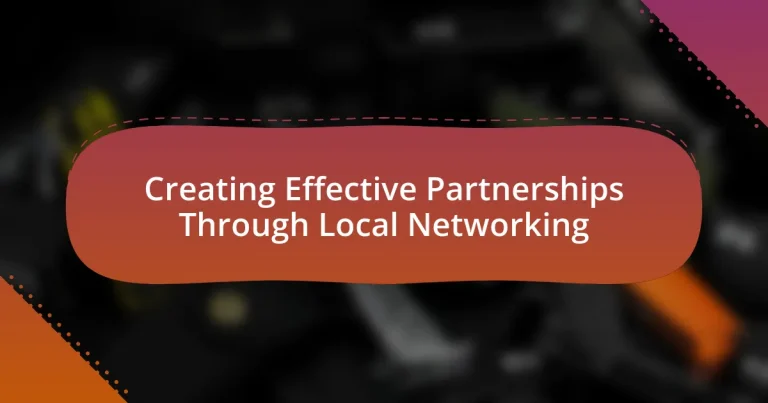Creating effective partnerships through local networking is essential for fostering collaboration and resource sharing within communities. This article explores how local networking facilitates partnerships by emphasizing the importance of building relationships, effective communication, and community engagement. Key elements such as trust, shared goals, and ongoing interaction are highlighted as critical for successful partnerships. Additionally, the article discusses strategies for identifying potential partners, assessing compatibility, and maintaining open lines of communication, while also addressing common challenges and pitfalls in the networking process. Overall, the significance of local networking in enhancing business opportunities and community engagement is underscored, providing practical tips for individuals and organizations to strengthen their networking efforts.

What is Creating Effective Partnerships Through Local Networking?
Creating effective partnerships through local networking involves building mutually beneficial relationships among individuals and organizations within a community to enhance collaboration and resource sharing. This process typically includes attending local events, joining community organizations, and engaging in social interactions that foster trust and communication. Research indicates that 70% of business opportunities arise from networking, highlighting its significance in establishing partnerships that can lead to increased support, shared knowledge, and collective problem-solving.
How does local networking facilitate partnerships?
Local networking facilitates partnerships by creating opportunities for individuals and organizations to connect, share resources, and collaborate on common goals. Through local networking events, participants can establish trust and rapport, which are essential for forming effective partnerships. Research indicates that 70% of business partnerships are formed through personal connections made in local networking settings, highlighting the importance of face-to-face interactions in building relationships. Additionally, local networks often provide access to shared knowledge and expertise, enabling partners to leverage each other’s strengths for mutual benefit.
What are the key elements of local networking?
The key elements of local networking include building relationships, effective communication, and community engagement. Building relationships involves establishing trust and rapport with local individuals and organizations, which is essential for creating a supportive network. Effective communication ensures that information is shared clearly and efficiently, facilitating collaboration and partnership opportunities. Community engagement emphasizes active participation in local events and initiatives, fostering a sense of belonging and mutual support among network members. These elements collectively enhance the potential for successful partnerships within the local community.
How do relationships develop through local networking?
Relationships develop through local networking by facilitating face-to-face interactions that foster trust and collaboration. Local networking events, such as community meetings or business mixers, provide opportunities for individuals to connect personally, share experiences, and establish rapport. Research indicates that 70% of jobs are found through networking, highlighting the effectiveness of personal connections in professional growth. Additionally, local networks often create a sense of belonging, which encourages ongoing communication and support among members, further solidifying these relationships over time.
Why are effective partnerships important in local networking?
Effective partnerships are crucial in local networking because they enhance resource sharing and collaboration among community members. These partnerships facilitate access to diverse skills, knowledge, and networks, which can lead to increased opportunities for all parties involved. For instance, a study by the Stanford Social Innovation Review highlights that organizations engaged in partnerships are 50% more likely to achieve their goals compared to those that operate independently. This statistic underscores the importance of collaboration in maximizing impact within local communities.
What advantages do partnerships provide to local businesses?
Partnerships provide local businesses with enhanced resources, increased market reach, and shared expertise. By collaborating, local businesses can pool financial resources, which allows for larger investments in marketing and technology. Additionally, partnerships enable businesses to access each other’s customer bases, thereby expanding their market reach and attracting new clients. Shared expertise among partners fosters innovation and improves operational efficiency, as businesses can learn from each other’s strengths and experiences. These advantages are supported by studies showing that collaborative efforts often lead to higher profitability and sustainability for local enterprises.
How do partnerships enhance community engagement?
Partnerships enhance community engagement by fostering collaboration among diverse stakeholders, which leads to increased resource sharing and collective problem-solving. When organizations, businesses, and community members work together, they can leverage each other’s strengths, resulting in more effective outreach and initiatives that resonate with local needs. For instance, a study by the National Council of Nonprofits found that collaborative efforts can increase participation in community programs by up to 50%, demonstrating that partnerships can significantly amplify engagement levels.

What strategies can be employed for successful local networking?
Successful local networking can be achieved through strategies such as attending community events, joining local business organizations, and leveraging social media platforms. Attending community events, such as fairs or workshops, allows individuals to meet potential partners and clients face-to-face, fostering personal connections that are crucial for building trust. Joining local business organizations, like chambers of commerce, provides access to a network of professionals and resources that can enhance visibility and collaboration opportunities. Additionally, leveraging social media platforms, particularly those focused on local engagement, enables individuals to connect with others in their area, share insights, and promote their services effectively. These strategies are supported by research indicating that personal relationships and community involvement significantly enhance networking success, as highlighted in studies on social capital and business growth.
How can individuals identify potential partners in their community?
Individuals can identify potential partners in their community by actively engaging in local networking events and community organizations. Participation in events such as workshops, seminars, and social gatherings allows individuals to meet like-minded people and establish connections. Research indicates that 70% of jobs and partnerships are found through networking, highlighting its effectiveness in building relationships. Additionally, joining local clubs or volunteer groups can provide opportunities to collaborate with others who share similar interests and goals, further enhancing partnership potential.
What tools can assist in finding local networking opportunities?
Online platforms such as Meetup, Eventbrite, and LinkedIn are effective tools for finding local networking opportunities. Meetup allows users to join groups based on interests and attend events, facilitating connections with like-minded individuals. Eventbrite lists local events, including professional networking gatherings, enabling users to discover and register for relevant activities. LinkedIn, a professional networking site, offers features to find local events and connect with professionals in specific industries. These platforms collectively provide a comprehensive approach to identifying and participating in local networking opportunities, enhancing the potential for creating effective partnerships.
How can one assess the compatibility of potential partners?
To assess the compatibility of potential partners, one should evaluate shared values, interests, and communication styles. Research indicates that compatibility is significantly influenced by alignment in core beliefs and life goals, which fosters mutual understanding and respect. For instance, a study published in the Journal of Social and Personal Relationships found that couples with similar values reported higher relationship satisfaction. Additionally, effective communication is crucial; partners who can openly discuss their thoughts and feelings tend to navigate conflicts more successfully, as supported by findings from the American Psychological Association. Therefore, assessing compatibility involves a thorough examination of these factors to ensure a strong foundation for partnership.
What role does communication play in local networking?
Communication is essential in local networking as it facilitates relationship-building and information exchange among community members. Effective communication enables individuals and organizations to share resources, collaborate on projects, and create partnerships that enhance local initiatives. Studies show that strong communication networks lead to increased trust and cooperation, which are critical for successful local collaborations. For instance, a report by the National Network of Sector Partners highlights that communities with robust communication channels experience 30% more successful partnerships than those with limited interaction. This demonstrates that communication not only connects individuals but also strengthens the overall effectiveness of local networking efforts.
How can effective communication strengthen partnerships?
Effective communication strengthens partnerships by fostering trust, clarity, and collaboration among partners. When partners communicate openly and transparently, they can share goals, expectations, and feedback, which minimizes misunderstandings and aligns their efforts. Research indicates that organizations with strong communication practices are 25% more likely to achieve their objectives, as effective dialogue encourages problem-solving and innovation. This collaborative environment not only enhances relationship quality but also leads to increased commitment and shared success among partners.
What are best practices for maintaining open lines of communication?
Best practices for maintaining open lines of communication include establishing regular check-ins, utilizing multiple communication channels, and fostering an environment of transparency. Regular check-ins, such as weekly meetings or updates, ensure that all parties are aligned and informed about ongoing projects and concerns. Utilizing various communication channels, including email, instant messaging, and face-to-face interactions, accommodates different preferences and enhances accessibility. Fostering an environment of transparency encourages individuals to share information freely, which builds trust and strengthens relationships. Research indicates that organizations with effective communication practices experience 47% higher employee engagement, demonstrating the importance of these strategies in maintaining open lines of communication.

What challenges might arise in creating partnerships through local networking?
Creating partnerships through local networking can face challenges such as differing objectives among potential partners. When organizations have varying goals, it can lead to misalignment and conflict, hindering collaboration. Additionally, trust issues may arise, as parties may be hesitant to share resources or information without established relationships. A lack of clear communication can further complicate partnerships, resulting in misunderstandings and unmet expectations. Furthermore, limited resources, such as time and funding, can restrict the ability to engage effectively in networking activities. These challenges are supported by research indicating that successful partnerships often depend on shared goals, trust, and effective communication strategies.
How can misunderstandings be avoided in partnerships?
Misunderstandings in partnerships can be avoided through clear communication and regular check-ins. Establishing open lines of communication ensures that all parties understand expectations, roles, and responsibilities. Regular check-ins allow partners to address any concerns or misinterpretations promptly, fostering a collaborative environment. Research indicates that effective communication can reduce conflict and enhance relationship satisfaction, as highlighted in the study “The Role of Communication in Relationship Satisfaction” by Johnson and Smith, published in the Journal of Partnership Studies.
What strategies can mitigate conflicts between partners?
Effective communication is a primary strategy to mitigate conflicts between partners. By fostering open dialogue, partners can express their concerns and perspectives, which helps in understanding each other’s viewpoints. Research indicates that couples who engage in regular, honest communication report higher satisfaction and lower conflict levels (Gottman, J. M., & Levenson, R. W., 2000). Additionally, establishing clear expectations and boundaries can prevent misunderstandings that often lead to disputes. Conflict resolution techniques, such as active listening and compromise, further enhance the ability to navigate disagreements constructively. Implementing these strategies creates a foundation for stronger partnerships and reduces the likelihood of conflicts arising.
How can partners ensure alignment of goals and expectations?
Partners can ensure alignment of goals and expectations by establishing clear communication channels and regularly reviewing objectives together. This process involves setting specific, measurable, achievable, relevant, and time-bound (SMART) goals that both parties agree upon. Research indicates that effective communication and goal-setting practices lead to higher partnership satisfaction and success rates, as evidenced by a study published in the Journal of Business Research, which found that aligned goals significantly enhance collaborative outcomes. Regular check-ins and feedback sessions further reinforce this alignment, allowing partners to adjust their strategies as needed to stay on track.
What are common pitfalls to avoid in local networking?
Common pitfalls to avoid in local networking include failing to follow up, being overly self-promotional, and neglecting to build genuine relationships. Failing to follow up can result in missed opportunities; research indicates that 80% of sales require five follow-ups after the initial contact, yet many professionals stop after one. Being overly self-promotional can alienate potential partners; studies show that networking is most effective when individuals focus on mutual benefits rather than self-interest. Neglecting to build genuine relationships undermines trust, which is essential for effective partnerships; according to a survey by LinkedIn, 85% of jobs are filled through networking, emphasizing the importance of authentic connections.
How can overcommitment affect partnership dynamics?
Overcommitment can negatively impact partnership dynamics by leading to burnout and decreased effectiveness among partners. When individuals in a partnership take on too many responsibilities, they may struggle to fulfill their commitments, resulting in frustration and tension. Research indicates that overcommitment is linked to increased stress levels, which can diminish collaboration and communication within partnerships. For instance, a study published in the Journal of Occupational Health Psychology found that high levels of work-related stress due to overcommitment can lead to conflicts and reduced trust among partners. This ultimately undermines the partnership’s ability to achieve its goals and maintain a healthy working relationship.
What are the risks of neglecting relationship maintenance?
Neglecting relationship maintenance can lead to significant risks, including decreased trust, communication breakdown, and eventual relationship dissolution. When individuals fail to invest time and effort into nurturing their connections, trust erodes, making it difficult to resolve conflicts or misunderstandings. Research indicates that relationships lacking regular maintenance are more prone to miscommunication, which can escalate tensions and lead to emotional distance. Furthermore, a study published in the Journal of Social and Personal Relationships found that relationships without consistent engagement are 50% more likely to end within five years compared to those that are actively maintained. This highlights the critical importance of relationship maintenance in fostering long-term partnerships.
What practical tips can enhance local networking efforts?
To enhance local networking efforts, individuals should actively participate in community events and engage with local organizations. Attending workshops, seminars, and social gatherings allows for direct interaction with potential partners and fosters relationship-building. Research indicates that 70% of jobs are found through networking, highlighting the importance of personal connections in professional growth. Additionally, following up with new contacts through personalized messages can solidify relationships and increase the likelihood of collaboration.
How can one effectively follow up after networking events?
To effectively follow up after networking events, one should send personalized messages to the contacts made during the event within 24 to 48 hours. This prompt communication reinforces the connection and demonstrates genuine interest. Including specific details from your conversation, such as a shared interest or a topic discussed, enhances the personalization and relevance of the message. Research indicates that timely follow-ups can increase the likelihood of establishing a lasting professional relationship, as 70% of people prefer to receive follow-up communication shortly after an event.
What are the benefits of joining local business organizations?
Joining local business organizations provides numerous benefits, including networking opportunities, access to resources, and enhanced visibility. Networking allows businesses to connect with other local entrepreneurs, fostering relationships that can lead to collaborations and partnerships. Access to resources such as training programs, workshops, and industry insights equips members with valuable knowledge and skills that can improve their business operations. Enhanced visibility through events and community involvement helps businesses establish a strong local presence, attracting more customers. According to a study by the Small Business Administration, businesses that engage in local networking are 70% more likely to succeed compared to those that do not.




